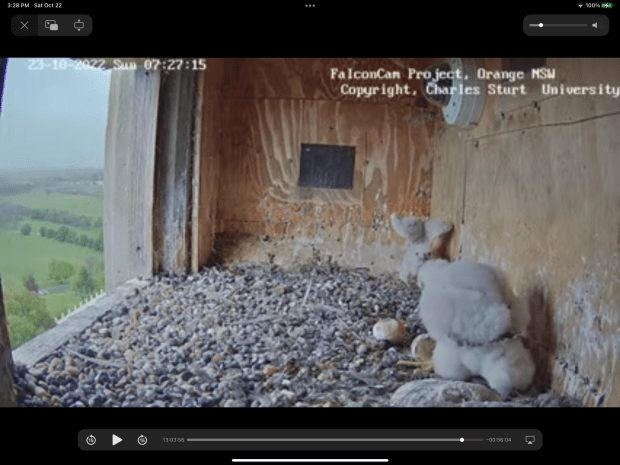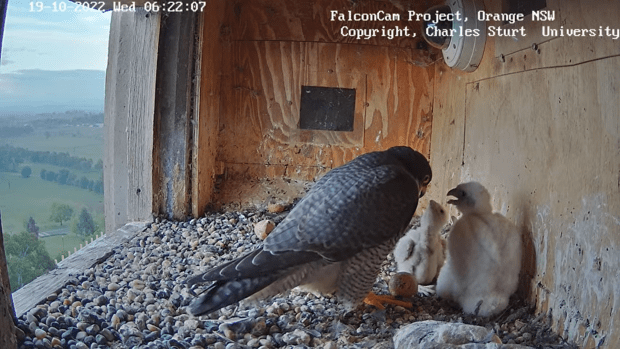26 November 2022
Good Morning Everyone,
The kittens thought it was about time that they got their pictures in the blog – again! It is almost impossible to actually call them kittens now. They are 4x the size they were when they arrived. That will be a month on Tuesday. If you look closely at Lewis, you will notice that his nose has some scratches. Those scratches are from his ‘sweet’ ‘never do anything wrong’ sister, Missy. Poor little, Lewis. She took a couple of nicks out of his left eye, too. Ah, it is always the quiet ones, eh, Lewis?




I am going to start off with some really good news. I know that any time we are feeling a little ‘low’, Ervie can always make us smile. Port Lincoln Osprey posted a video of Ervie enjoying a freshly caught fish at Delamere this morning. I wonder if he was out fishing with Dad?

Now for the worrisome. Rubus has not been seen since the 23rd when he was on the ridge of the building. There has been a break in the news and I just thought it was because Cilla had not been out and about but, turns out, Indigo has been seen and photographed but not our sweet little lad.
I have received a note from ‘J’ that included this announcement from Cilla Kinross. It says: “I am organising a bit of search tomorrow morning at 0830 with some locals. Not sure how many will turn up, but hopefully 3 or 4 so we can split up and have a good look for Rubus. The bird wil go to a raptor carer and if and when he’s returned, I’ll decide at that stage. Probably I would put him close to Indigo so easy for parents to find.”
This is not the news that we had hoped. Let us all get really positive and send that energy out to the grounds of Orange to help our wee lad.
I found this message from Cilla below the streaming cam: “NEWS 26th November 2022 1900h I had a good look around this morning. No sign of Rubus. I asked Security to keep an eye for him, especially if he was on the ground. Indigo was sitting quietly in the trees in Girinyalanha and I took some photos.”

At 1450, Indigo flew into the scrape box looking for leftovers and hoping for prey. He is big and strong and gorgeous.


Here is a video of Indigo arriving in the scrape box with prey!
Oh, what a darling Xavier is. He went into the scrape just to see how Indigo was making out with his prey. They are taking such good care and teaching Indigo such valuable lessons. Oh, I hope dear Rubus is found so that the family can be back together again soon.
Xavier you are the cutest!

It was certainly good news to see that Willow, Louis and Dorcha’s first fledgling of 2022 had been spotted in the same area as Paith from the Dyfi nest. There must be a message board somewhere for young osprey fledglings from the UK on good places to stop enroute to their winter vacation (or should I say their home for the next couple of years?).
Yesterday it was a bit of a feast at the Port Lincoln Osprey nest and this morning an extremely large flat fish (a flounder? they do have them in PL) appeared on the nest. Mum flew in when Dad arrived but Zoe took charge. Now, that fish was big enough to feed three but, it didn’t. Zoe ate every last bit of it. She worked on that fish for more than two hours!!!!!!!!! Mum gave up and went off to get her own. I can only imagine the number of fish Zoe’s mate is going to have to produce when she has a nest of osplets. Just think about it. I am not certain I have ever seen an osplet eat as much fish as our Zoe.


Mum waited for over an hour hoping to get some breakfast but, the fact is, Zoe does not share.

At one time there were gulls overhead and both Mum and Zoe were alarming.



No 16. The Red List. The White-fronted Goose

“Greater White-fronted Goose” by Rick Leche is licensed under CC BY-NC-ND 2.0.
Oh, goodness. Isn’t that a beautiful goose? White-fronted geese are medium sized. The white face is set off by that taupe of the head and back, the splotched chest, and that orange bill of the Greenland geese with legs to match. On occasion, the bill can be pinkish – that of the Siberian birds. There is a fluffy white bottom under those grey-brown back and wing feathers. What is amazing is the ombre – going from the solid taupe head, to the lighter neck, then lighter still on the breast. Just imagine if someone took this into their hair salon and asked for the stylist to copy it! It would be quite stunning, actually. Females and males are similar while the juveniles lack the white face, the black barring, and their taupe colour is not as deep as that of the adults.

“Greater White-fronted Goose (Anser albifrons) DSC_0139” by NDomer73 is licensed under CC BY-NC-ND 2.0.
They breed in the cold of the Arctic tundra areas in the spring and summer. Greenland is one of the sites. In his entry, Gill Lewis writes, “This Greenland summer has seen her new brood hatch and grow. Her proud gaggle follow her, tail-waggling and beak-nibbling on the arctic tundra. A family, feeding and fattening.” In his entry, David Stroud said, “…she hatched six goslings and, with her mate, led them three kilometres up the steep valley sides and onto the lake-studded plateau used for brood-rearing and moulting.” Can you imagine, those wee ones following behind their Mum and walking upwards for 3 kilometres? It would be an incredible sight. They eat grasses, clover, grain, winter wheat and potatoes, according to the RSPB.
These lovely geese then fly and spend their winters in Ireland, the Orkneys, and Britain.
Why are these lovely waterfowl on such rapid decline? It is interesting and can be remedied. But, first. In 1982 shooting of White-fronted Geese in the UK was outlawed. Even so, their numbers have been falling rapidly. There are simply not enough youngsters to replace the adults and the cause is well known. The warming of the North Atlantic is the primary cause with its climatic changes and heavy snow falls. Those snows are arriving earlier and earlier at a time when the geese need feed before laying their eggs. So little food. One other cause, the one that can be remedied and is being done so for some species is wetlands. Instead of draining land so that humans can take over more and more vast tracks of it, we need to stop and rebuild the wetlands that are required for all our waterfowl. Whether or not anyone will find a way to halt or even slow the warming of our planet with its land and oceans is another story – a particularly grim one. So sad, these geese have been flying back and forth from the Arctic to the UK for 2 million years – just think about it. And, oh, how quickly we have ruined the entire landscape for them – in a blink of that time.
So when rewilding and news of the creation of wetlands comes to your ears, stand up in support of it – and remember the White-fronted Goose when you do.

“Greater White-fronted Goose (Anser albifrons) DSC_0132” by NDomer73 is licensed under CC BY-NC-ND 2.0.
In the News:

“Long-Billed Curlews” by FotoGrazio is licensed under CC BY-NC-ND 2.0.
The Curlew. These amazing shorebirds with their extremely long curved beaks are also in rapid decline. Oh, how I love reading these short Country Diary Posts. I hope you do, too.
https://www.theguardian.com/environment/2022/nov/25/country-diary-a-cloud-of-curlews-carries-me-away
Thank you so much for being with me this morning. Let us all collectively send our warmest and most positive wishes to Orange so that Rubus might be found safely and be cared for as he needs. Take care all. See you soon.
Thank you to the following for the posts and streaming cams that make up my screen captures: Port Lincoln Osprey, Port Lincoln Osprey FB, Orange Australia Falcon FB, Charles Sturt Falcon Cam and Cilla Kinross, Openverse, and The Guardian.































































































































































































































